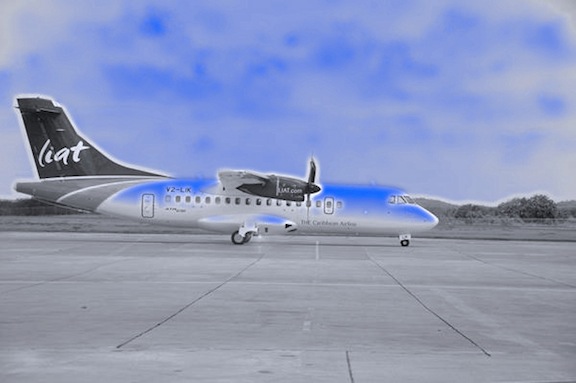LIAT CEO: How to Improve Caribbean Aviation in Six Steps
By David Evans
Op-Ed Contributor
BOTH THE history and the current reality of Caribbean aviation can be characterised by a consistent failure over the last 50 years to provide an efficient air transportation system that meets the needs of the 40 million plus inhabitants of the region.
The reasons for this failure are many and varied — chronic undercapitalization, economic adversity, sparse populations, poor hub structures, lack of investment in infrastructure and skills training and technology, political interference, trade union activism, national self-interest, and a reluctance to work together towards a common goal.
Set against this rather bleak picture is the long-held dream of a single Caribbean airline providing efficient and affordable air transportation, connecting the peoples of the region, connecting the region to the rest of the world, and acting as an engine for economic growth.
The distinct lack of progress towards the realisation of this dream suggests that it is probably unachievable without the political and economic cohesion that would allow such a concept to develop. Nevertheless, I believe there are elements of the concept that can be achieved with the active participation of the key stakeholders. In his famously mistranslated quote, Lao Tzu maintains that” a journey of a thousand miles begins with a single step.” I will be so bold as to propose six steps.
1) a political framework. Caricom consists of 19 full and associated member states. It has created a Transportation Commission, an aviation and safety oversight system, and an advance passenger information system (APIS). Yet only a handful of governments and airlines participate in these bodies. All the governments and all the airlines of Caricom states should commit to full participation in these bodies and devote serious time and effort to delivering air transport benefits to their populations.
2) government ownership of airlines. In his 2010 book “Don’t Burn Our Bridges,” Jean Holder, LIAT Chairman, presents an eloquent case for government ownership of airlines on the simple premise that governments in the region simply cannot afford to leave such a strategically important industry as aviation exposed to the harsh economic realities of commercial aviation. The recent disappearance of American Eagle from the region underscores his point. On the other hand, with regional governments being if anything, even more cash strapped than the airlines they own, there must be a case for encouraging private investment with governments maintaining a golden share. This in turn would require these airlines to deliver an adequate return on capital invested, but without raising fares beyond the ability of their customers to pay. This is a balancing act but can be achieved by driving out the large costs and inefficiencies that exist in all Caribbean airlines without having to resort to price increases.
3) Taxation on aviation. For every $3 spent on air travel in the region, $1 goes straight into government treasuries. I have argued that a reduction in taxation on aviation would increase demand and actually increase the tax take back to the governments. If such economic liberalism is too rich for financially risk averse governments, then I would propose a small but important gesture: the removal of the tax on children travelling by air. There is hardly a moral or ethical case to be made for taxation on children, it is moderately risk free, and would probably be seen as politically popular.
4) Passenger facilitation. Transferring from one flight to another in the region is a tortuous process due to differing security procedures. The endless completion of lengthy immigration forms to be presented after lengthy immigration queues is equally mind-numbing. Customs regulations and working practices in some countries that stipulate that their officials only work on weekdays and require airlines to pay their overtime for their attendance outside these hours have no place in 21st century aviation. There are political, legislative, and technological solutions for all of these issues, and the travelling public would be mighty grateful to see them implemented.
5) Physical connectivity. The Caribbean airline members of the Association of Latin American and Caribbean Airlines (ALTA) should form their own subset of the association. These airlines should then commission a fleet and network planning expert to take all of the aircraft assets in the group, and as a planning exercise construct an optimum fleet and network plan with costs and revenues and route profitability statements, free of individual ownership considerations. The resulting numbers may be sufficiently attractive for those airlines to consider some form of alliance.
6) Virtual connectivity. All airlines rely on a host reservation system through which they sell and distribute their products. In large airlines these systems are usually Global Distribution Systems(GDS) which talk to other airlines and allow global connectivity and commercial agreements amongst the airline community. Historically, these systems have been expensive to acquire and expensive to operate, and often beyond the financial reach of a small regional airline.
More recently, however, the rise of alternative and cheaper web-based distribution platforms have put pricing pressure on the traditional GDS, and as a consequence some airlines have moved away from these providers. However, the new distribution platforms usually fail to provide full connectivity with the large global airlines.
The Caribbean region is one of the few regions of the world where the traditional GDS have not gained a strong foothold and the prospect of acquiring the business of all of the airlines in the region may be sufficiently attractive for them to offer an economically viable proposition to the carriers.
If this were to come to fruition, at a stroke the Caribbean regional airlines would be connected to the global airline distribution system with all the concomitant benefits that would accrue from linking the intercontinental airlines to the regional airline system.
These six steps may fall some way short of the dream of a single Caribbean airline and will require time, effort, political will and a healthy amount of plain goodwill from all of the stakeholders, but it would be heartening to see a start along the journey.
David Evans is the Chief Executive Officer of LIAT, Ltd.
Note: the opinions expressed in Caribbean Journal Op-Eds are those of the author and do not necessarily reflect the views of the Caribbean Journal.








